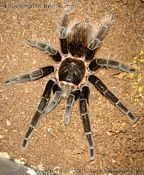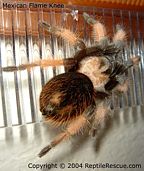Mexican Red Knee Tarantula Care
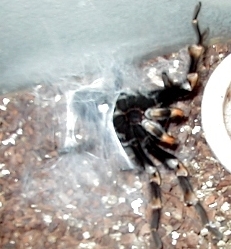 |
| This male Mexican Red Knee only spins this cocoon type web when he is ready to mate. |
Common Name: Mexican Red Knee Tarantula
Please Note: This care sheet is for the Mexican Red Knee Tarantula only. I have included pics of all my tarantulas here and I will eventually be posting specific care sheets for each species. Some pics link to a larger close-up shot.
Scientific Name: Brachypelma smithi
Homeland: Mexico
Size: Start out the size of a tiny pinkie nail and grow to be a bit smaller than my hand. Sexually mature in 5 years if fed properly and housing is correct.
LifeSpan: I have heard so many stories from all the experts and they are all different. My oldest female died at 16 years and males typically live 4-5 years
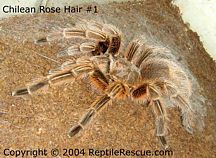 Cage:
Cage:
Babies need to be in a small cage or container since they may not be able to find food in a big house. I raised my little "Scooter" in a test tube for the first few months and moved up to a Margarine tub. This allowed him to find food and grow. Poke several small air holes and your ready to go. I have seen disposable Tupperware style tubs from Glad that are see through that should work fine. There cheap and easy to clean. I recommend the adults to be kept in a 10-gallon tank with ventilation but avoid a screen lid. As they climb they often seem to get there little feet caught in the screen and end up just dangling helpless. I recently found tank tops at Petco that are sold separatley that have a metal screen with larger holes. I have replaced all my 10 gallon metal mesh tops with these and I have not had a dangling spider since. A ten gallon tank should be cleaned out every couple months along with taking out leftover food bits as necessary to avoid bacteria. If it smells you know your not cleaning enough.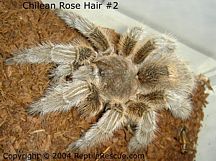
They also need a shelter. Those wood logs cut in half work great. Always provide fresh water in a low small bowl for adults. For hatchlings I just use a 2 liter soda bottle cap.
Substrate: I use the T-Rex Forest Bedding, but I freeze it for 30 days first to kill any mites that may be along for the ride. Herbicide/pesticide free organic potting soil mixed with vermiculite works well too. Both allow for humidity. These guys need humidity to molt properly. I will mist the bottom of the cage occasionaly, just don't get the little guy wet or you'll have an unhappy arachnid. Misting can create a mold problem if there is not enough ventilation. (See Temperature for more on this)
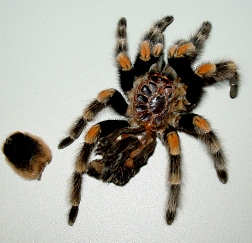 |
| This is a molt from a Mexican Red Knee. |
Temperatue:
A small heat panel stuck to the bottom of the cage seems to keep the perfect temp in the cage for them. Also, the heat panel helps create humidity when misting the bottom of the cage. I lay a piece of saran wrap over 3/4 of the cage top. This keeps humidty in and allows for fresh air flow.
Shedding: They do, but it's called molting. Their skeleton is on the exterior of their body and they molt it off frequently as spiderlings, then once a year as adults. First they won't eat for 2-3 weeks prior to molting. When you see your tarantula on his back, don't p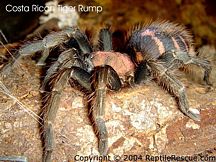 anic and do not touch him. This is normal at molting time. Moving him could kill him. Make sure there is no live food in the cage. He will return to normal in a few days and you will have an incredible looking duplicate of you pet tarantula to scare your friends with. Give them a few days torecover before offering food
anic and do not touch him. This is normal at molting time. Moving him could kill him. Make sure there is no live food in the cage. He will return to normal in a few days and you will have an incredible looking duplicate of you pet tarantula to scare your friends with. Give them a few days torecover before offering food
Feeding:
I feed all my tarantulas a variety of crickets, cockroaches, king mealworms, and adults will get pinkie mouse maybe every two months. I have even been able to trick my tarantuals into eating a defrosted dead pinkie using tweezers and gently recreating the pinkie moving near him by lightly touching the hairs on his legs.Luckily most of my tarantulas readly eat dead pinkies. 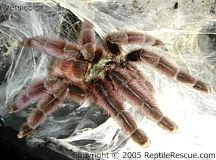 Always feed your tarantulas one live food item at a time. People tend to throw in a handlful of crickets. This will just agitate the tarantula and if the crickets get hungry they can hurt your tarantula. Mealworms and roaches need to be watched, drop it next to your spider, if he does not grab it right away they will just burrow. Lighting: They
Always feed your tarantulas one live food item at a time. People tend to throw in a handlful of crickets. This will just agitate the tarantula and if the crickets get hungry they can hurt your tarantula. Mealworms and roaches need to be watched, drop it next to your spider, if he does not grab it right away they will just burrow. Lighting: They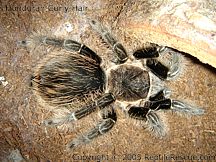 are nocturnal so I don't recommend lighting the cage.
are nocturnal so I don't recommend lighting the cage.
This and that:
These spiders seem to be the best kept tarantulas. Graceful in movement and beautiful to watch. Handling on a regular basis does not seem to bother them but I limit my holding time to shows. One or two 10 minute displays per week. I have never experienced an aggressive action at this pace. There are times I pick them up and they kick butt hairs like crazy. Best to leave them alone for the rest of the day. Also, when you notice their eating habits stopping it may be time to molt soon, so I would leave them alone at this time too.
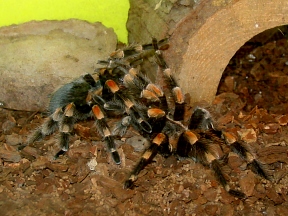 |
| These Mexican Red Knees are getting ready to mate. |
SnakeBabe's Pet rating: Excellent
Easy to feed and water. No odor at all. Keep in mind that they can break if you drop them. If you are leary of holding them, do so over a blanket or something soft. This always a good idea when handling as you never know if they will take off over your hand. They are interesting to watch move but not much for relationships. Great if you just like a living decoration in your home. Go for it if you want something to look at with minimal care.
